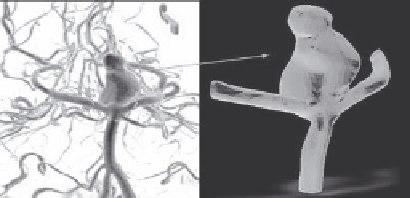Biomedical Engineering Reference
In-Depth Information
(a)
(b)
FIGURE 6.2
(a) CTA image of a basilar artery aneurysm, (b) aneurysm model of a basilar
artery using Materialise software.
6.7 Results and Discussion
We studied the effect of the neck size on the temporal variations of the flow
patterns and average pressure within the aneurysm sac without the presence
of the coil as shown in Figures 6.3 and 6.4. Both figures show how blood
flows through the lumen of the artery, and impinges on the distal edge of
the aneurysmal neck. The impinged flow splits into two streams: one smaller
jet enters the aneurysm sac at the distal edge of the neck while the bulk of
the blood stream flows though the parent vessel. The blood flow within the
aneurysm recirculates and travels in a direction retrograde to the flow in the
main arterial lumen until it is entrained into the mainstream flow in the par-
ent vessel. This results in a retrograde vortex forming inside the aneurysm sac
with its center near the distal end as shown in Figures 6.3 and 6.4. Although
the aneurysm vortex is present throughout the entire cardiac cycle, its mag-
nitude is the greatest at the end of the acceleration phase (peak-flow velocity
condition). The strength of the vortex is larger for a wide-necked aneurysm
than for a narrow-necked aneurysm. This can be attributed to the fact that an
aneurysm with a wide-neck has a larger opening allowing for a larger veloc-
ity jet stream to enter the aneurysm sac from the parent vessel than in a
narrow-necked aneurysm.
The effect of coil embolization on the flow patterns and pressure within a
narrow-necked aneurysm sac is illustrated in Figure 6.5. Owing to the absence
of such data in the literature, we assumed a homogenous packing density of the
order of 20% (realistic clinical assumption [58]), resulting in uniform porosity,
ε
= const = 0.8, everywhere in the aneurysm. Selecting the permeability value
and therefore the Darcy number (Da) is more dicult because of the semiem-
pirical nature of the corresponding terms. In most engineering applications,
the value of permeability is usually determined experimentally. In our case,


Search WWH ::

Custom Search